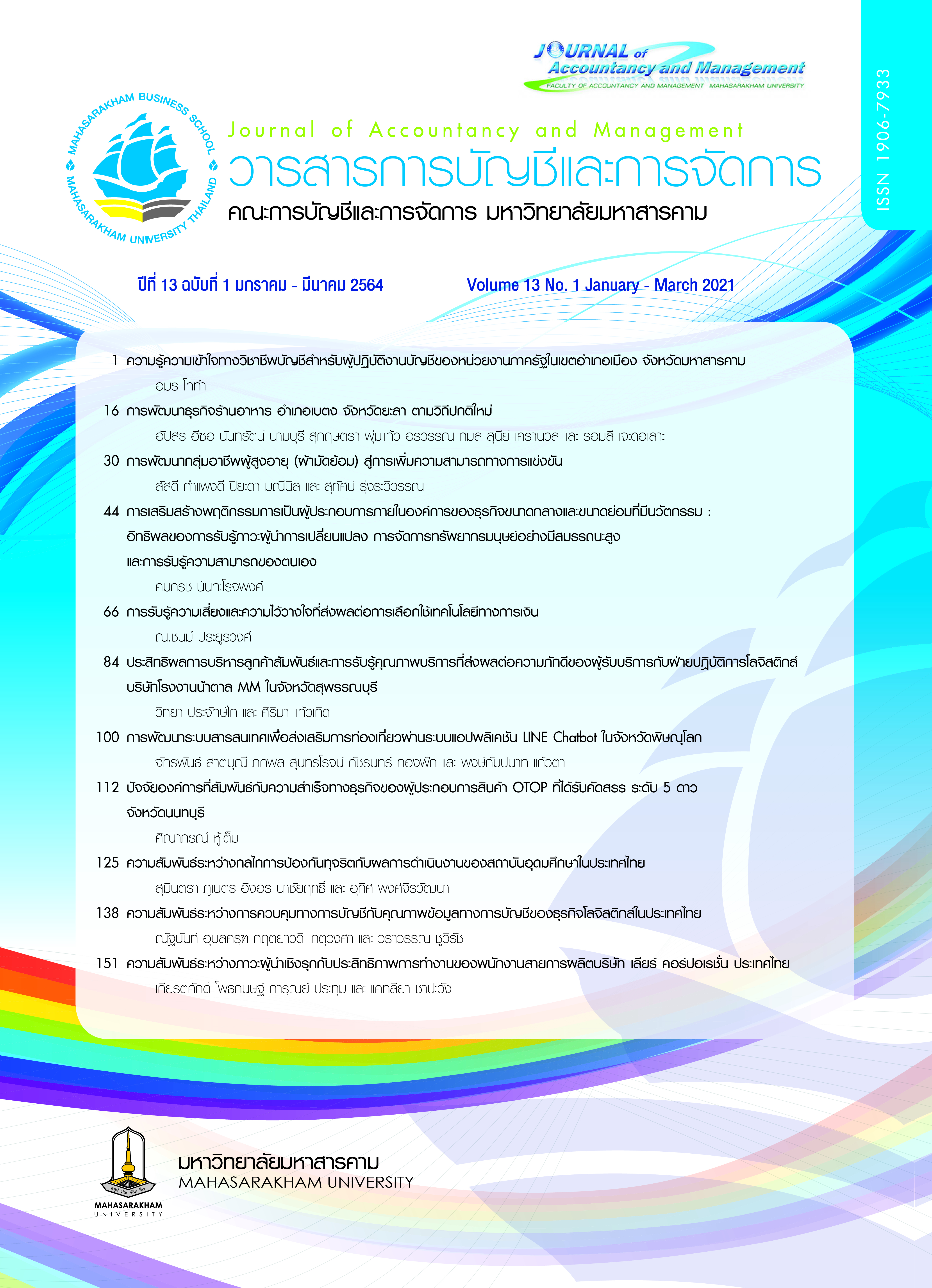การรับรู้ความเสี่ยงและความไว้วางใจที่ส่งผลต่อการเลือกใช้เทคโนโลยีทางการเงิน
Main Article Content
บทคัดย่อ
การศึกษาวิจัยครั้งนี้มีวัตถุประสงค์ เพื่อศึกษาการรับรู้ความเสี่ยง ความไว้วางใจในการเลือกใช้เทคโนโลยีทางการเงิน
เพื่อศึกษาความสัมพันธ์ระหว่างการรับรู้ความเสี่ยงและความไว้วางใจในการเลือกใช้เทคโนโลยีทางการเงินและศึกษาอิทธิพล
ของการรับรู้ความเสี่ยงและความไว้วางใจของผู้ใช้บริการที่มีผลต่อการเลือกใช้เทคโนโลยีทางการเงิน กลุ่มตัวอย่าง คือประชาชน
ที่อยู่ในเขตอำเภอบางกรวย จังหวัดนนทบุรี วิธีได้มาซึ่งกลุ่มตัวอย่างได้โดยการสุ่มแบบสะดวก และใช้แบบสอบถามเป็นเครื่องมือ
ในการวิจัย สถิติที่ใช้ในการวิเคราะห์ข้อมูล คือ ค่าร้อยละ ค่าเฉลี่ย ค่าเบี่ยงเบนมาตรฐาน การวิเคราะห์สัมประสิทธิ์สหสัมพันธ์
แบบเพียร์สันและการวิเคราะห์การถดถอยโลจิสติกส์
ผลการวิจัย พบว่า ผู้ใช้บริการ Mobile banking (M-Banking) มีการรับรู้ความเสี่ยงมากที่สุดด้านทางการเงินและมีความไว้วางใจมากที่สุดด้านความสามารถในการให้บริการ ส่วน Mobile wallet (M-Wallet) มีการรับรู้ความเสี่ยงมากที่สุดด้านทางการเงิน
และมีความไว้วางใจมากที่สุดด้านความซื่อสัตย์ ส่วนผลการศึกษาความสัมพันธ์ระหว่างการรับรู้ความเสี่ยงและความไว้วางใจ
ในการเลือกใช้เทคโนโลยีทางการเงินของ M-Banking และ M-Wallet พบว่า การรับรู้ความเสี่ยงของ M-Banking และ
M-Wallet มีความสัมพันธ์กับความไว้วางใจในการเลือกใช้เทคโนโลยีทางการเงินในระดับสูง มีค่าความสัมพันธ์กันในทางบวก
และมีความสัมพันธ์กันในลักษณะที่คล้อยตามกัน และส่วนผลการศึกษาอิทธิพลของการรับรู้ความเสี่ยงและความไว้วางใจ
ของผู้ใช้บริการที่มีผลต่อการเลือกใช้เทคโนโลยีทางการเงิน พบว่า ปัจจัยความเสี่ยงและความไว้วางใจที่มีอิทธิพลต่อการเลือกใช้เทคโนโลยีทางการเงินของ M-Banking ได้แก่ ความไว้วางใจด้านความซื่อสัตย์ จะส่งผลให้การเลือกใช้เทคโนโลยีทางการเงิน M-Banking เพิ่มขึ้น ปัจจัยความเสี่ยงและความไว้วางใจที่มีอิทธิพลต่อการเลือกใช้เทคโนโลยีทางการเงินของ M-Wallet
คือ ความเสี่ยงด้านความเป็นส่วนตัวจะส่งผลให้การเลือกใช้เทคโนโลยีทางการเงิน M-Wallet เพิ่มขึ้น
Downloads
Article Details
บทความที่ได้รับการตีพิมพ์เป็นลิขสิทธิ์ของวารสารการบัญชีและการจัดการ
ข้อความที่ปรากฏในบทความแต่ละเรื่องในวารสารวิชาการเล่มนี้เป็นความคิดเห็นส่วนตัวของผู้เขียนแต่ละท่านไม่เกี่ยวข้องกับมหาวิทยาลัยมหาสารคาม และคณาจารย์ท่านอื่นๆในมหาวิทยาลัยฯ แต่อย่างใด ความรับผิดชอบองค์ประกอบทั้งหมดของบทความแต่ละเรื่องเป็นของผู้เขียนแต่ละท่าน หากมีความผิดพลาดใดๆ ผู้เขียนแต่ละท่านจะรับผิดชอบบทความของตนเองแต่ผู้เดียว
เอกสารอ้างอิง
ณัฐดนัย ใจชน. (2555) ปัจจัยที่มีผลต่อการเลือกใช้บริการจากธนาคารพาณิชย์ ในเขตกรุงเทพมหานคร. การศึกษาอิสระปริญญาบริหารธุรกิจมหาบัณฑิต, มหาวิทยาลัยเทคโนโลยีราชมงคลธัญบุรี.
ธนกฤต เงินอินต๊ะ. (2563). ความสัมพันธ์ระหว่างการบริหารการตลาดออนไลน์กับความสำเร็จของการตลาดออนไลน์ของธุรกิจ พาณิชย์อิเล็กทรอนิกส์ในประเทศไทย. วารสารการบัญชีและการจัดการ มหาวิทยาลัยมหาสารคาม, 12(2), 26-36.
ธนภรณ์ แสงโชต. (2561). การยอมรับเทคโนโลยี MyMo Mobile Banking บริบท ธนาคารออมสิน FinTech Adoption of MyMo Mobile Banking in Government Saving Bank. วิทยานิพนธ์มหาบัณฑิต มหาวิทยาลัยธรรมศาสตร์.
ธนาภา หิมารัตน์. (2559) ปัจจัยที่ส่งผลต่อการยอมรับเทคโนโลยีทางการเงิน บริบทธนาคารพาณิชย์. วิทยานิพนธ์มหาบัณฑิต การบริหารเทคโนโลยี วิทยาลัยนวัตกรรม มหาวิทยาลัยธรรมศาสตร์.
ฤทัยภัทร ทำว่อง. (2557). การตัดสินใจเลือกใช้บริการทางการเงินผ่านแอปพลิเคชันบนสมาร์ทโฟนของลูกค้า. วิทยานิพนธ์บัณฑิตศึกษา มหาวิทยาลัยเนชั่น.
สวรส อมรแก้ว. (2555). ปัจจัยด้านการรับรู้ความเสี่ยงที่มีอิทธิพลต่อพฤติกรรมการซื้อ สินค้าอาหารจากตลาดสดในกรุงเทพมหานครของผู้บริโภค. วิทยานิพนธ์บริหารธุรกิจมหาบัณฑิต สาขาวิชาการตลาด มหาวิทยาลัยศรีนครินทรวิโรฒ.
สุดารัตน์ ภูสมนึก.(2562). ความเชื่อมั่นในระบบการขำระเงินแบบอิเล็กทรอนิกส์ที่ส่งผลกระทบต่อประสิทธิภาพการดำเนินงานของ ส่วนราชการผู้เบิกในจังหวัดภายใต้สำนักงานคลังเขต 4. วารสารการบัญชีและการจัดการ มหาวิทยาลัยมหาสารคาม, 11(3), 93-104
สุวิมล มธุรส. (2556). การรับรู้การโฆษณาธนาคารทางโทรทัศน์ของผู้บริโภคในประเทศไทย. วิทยานิพนธ์มหาบัณฑิต มหาวิทยาลัยรังสิต.
ภาวิดา หม่อมปลัด. (2556) ความไว้วางใจด้านความปลอดภัยของผู้ใช้บริการที่มีต่อเทคโนโลยีการทำธุรกรรมการเงินผ่านโทรศัพท์มือถือในเขตกรุงเทพมหานคร. วิทยานิพนธ์มหาบัณฑิต มหาวิทยาลัยศรีปทุม.
Aggelidis, V. P., & Chatzoglou, P. D. (2016). Using a modified technology acceptance model in hospitals. International Journal of Medical Informatics, 78(2), 115-126.
Aldas-Manzano, J., Lassala-Navarré, C., Ruiz-Mafé, C., & Sanz-Blas, S. (2019). The role of consumer innovativeness and perceived risk in online banking usage. International Journal of Bank Marketing, 27(1), 53-75.
Black, N. J., Lockett, A., Ennew, C., Winklhofer, H., & McKechnie, S. (2012). Modelling consumer choice of distribution channels: an illustration from financial services. International Journal of Bank Marketing, 20(4), 161-173.
D. H., Choudhury, V., & Kacmar, C. (2012). Developing and Validating Trust Measures for e-Commerce. Information System Research, 13(3), 334-359.
Featherman, M., & Pavlou, P. A. (2003). Predicting e-services adoption: A perceived risk facets perspective. International Journal of Human-Computer Studies, 59(4), 451–474.
Hart, O. A., Nwibere, M. N., & Inyang, B. J. (2015). The uptake of electronic commerce by SMEs: A meta the oretical framework expanding the determining constructs of TAM and TOE frameworks. Journal of Global Business Technology, 6(1), 1-27.
Hoyer, W. T., & MacInnis, D. (1997). The Effect of Online Service Quality toward Perceived Risk, Customer Attitudes, Relationship Quality, Online Purchase Intention, E-Loyalty, and Purchasing Behavior. Consumer Behavior Houghton Mifflin, Boston MA.
Hoffman, D. L., & Novak, T. P. (1996). Marketing in hypermedia computer-mediated environments: conceptual foundations. Journal of Marketing, 60, 50-68.
Kuisma, T., Laukkanen, T., & Hiltunen, M. (2007). Mapping the reasons for resistance to internet banking: a eans-end approach. International Journal of Information Management, 27(2), 75–85.
Lee LK., et al. (2009). Menstruation among adolescent girls in Malaysia : a cross-sectional school survey. Singapore. Med J., 47(10), 869 – 74.
Lim, N. (2003). Consumer perceived risk: Sources versus consequences. Electronic Consumer Research and Applications, 2, 216-28.
Littler, D., & Melanthiou, D. (2006). Consumer perceptions of risk and uncertainty and the implications for behaviour towards innovative retail services: the case of internet banking. Journal of Retailing and Consumer Services, 13(6), 431-443.
Mathieson et al. (2010). Predicting use intention comparing the TAM with the theory of planed behavior. Information System Research, 12(3), 173-191.
Mayer, R. C., Davis, J. H., & Shoorman, F. D. (1995). An Integrative Model of Organizational Trust. Academy of Management Review 20(3), 709-734.
McKnight, D. H., Choudhury, V., & Kacmar, C. (2002). The impact of initial consumer trust intentions to transact with a Web site: A trust building model. Journal of Strategic Information Systems, 11(3–4), 297–323.
Morgan, R. M., & Hunt, S. D. (2014). The commitment-trust theory of relationship marketing. Journal of Marketing, 58(3), 23-38.
Nitin, N. & Nath, V. & Nanvy, G. (2014). A study of Adoption behavior of mobile banking service by Indian consumers. International Journal of Research in Engineering & Technology, 2, 209-222.
Rogers, E. M. (2003). Diffusion of innovations (5thed.). New York : Free Press.
Yu, S.-C. (2016). Older-users acceptance of smart card payment systems: An investigation of an old-street Venders. Information Science and Digital Content Technology (ICIDT), March,152-156.
Zhou. (2013). An empirical examination of user adoption of location-based services. Journal of Electronic Commerce Research, 13(1), 25-39.


